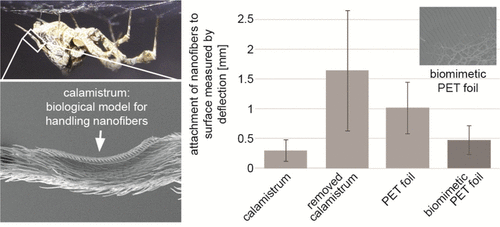当前位置:
X-MOL 学术
›
ACS Appl. Nano Mater.
›
论文详情
Our official English website, www.x-mol.net, welcomes your
feedback! (Note: you will need to create a separate account there.)
Biomimetic Combs as Antiadhesive Tools to Manipulate Nanofibers
ACS Applied Nano Materials ( IF 5.3 ) Pub Date : 2020-03-16 , DOI: 10.1021/acsanm.0c00130 Anna-Christin Joel 1, 2 , Marco Meyer 1 , Johannes Heitz 3 , Alexander Heiss 4 , Daesung Park 5, 6 , Hana Adamova 1 , Werner Baumgartner 7
ACS Applied Nano Materials ( IF 5.3 ) Pub Date : 2020-03-16 , DOI: 10.1021/acsanm.0c00130 Anna-Christin Joel 1, 2 , Marco Meyer 1 , Johannes Heitz 3 , Alexander Heiss 4 , Daesung Park 5, 6 , Hana Adamova 1 , Werner Baumgartner 7
Affiliation

|
Nanofibrous multifunctional materials have attracted a lot of attention because of the benefits of their special structure. Despite the diverse benefits of nanofibrous materials, their inherent stickiness to any surface is a major obstacle in producing and processing such materials. There are many paragons in which biological models or elements from nature have been biomimetically adapted in various areas in order to resolve technical problems, such as the silent flight of the owl, the lotus effect, or the sticky feet of the gecko. One special example shows us how nanofibers might be handled in the future: cribellate spiders possess a specialized comb, the calamistrum, on their hindmost legs, which is used to process and assemble nanofibers into structurally complex capture threads. Within this study, we were able to prove that these fibers do not stick to the calamistrum because of a special fingerprint-like nanostructure on the comb. This structure prevents the nanofibers from smoothly adapting to the surface of the comb, thus minimizing contact and reducing the adhesive van der Waals forces between the nanofibers and surface. This leads to the spiders’ ability of nonsticky processing of nanofibers for their capture threads. The successful transfer of these structures to a technical surface proved that this biological model can be adapted to optimize future tools in technical areas in which antiadhesive handling of nanofibrous materials is required.
中文翻译:

仿生梳子作为操纵纳米纤维的抗粘附工具
纳米纤维多功能材料由于其特殊结构的优势而吸引了很多关注。尽管纳米纤维材料具有多种好处,但它们固有的对任何表面的粘性仍是生产和加工此类材料的主要障碍。为了解决技术问题,例如猫头鹰的无声飞行,荷花效应或壁虎的粘脚,在许多领域中都模仿了自然界的生物学模型或元素,从而解决了技术难题。一个特殊的例子向我们展示了未来如何处理纳米纤维:新月形蜘蛛的最后肢有专门的梳子,即夜曲,用于将纳米纤维加工和组装成结构复杂的捕获线。在这项研究中 我们能够证明,由于梳子上有特殊的指纹状纳米结构,这些纤维不会粘在发色团上。这种结构防止纳米纤维平滑地适应梳子的表面,从而使接触最小化并减小了纳米纤维与表面之间的范德华力。这导致蜘蛛对捕获纤维的纳米纤维进行非粘性处理。这些结构成功地转移到技术表面上,证明了该生物学模型可适用于在需要对纳米纤维材料进行防粘处理的技术领域中优化未来的工具。因此最小化了接触并减小了纳米纤维与表面之间的范德华力。这导致蜘蛛对捕获纤维的纳米纤维进行非粘性处理。这些结构成功转移到技术表面上,证明了该生物学模型可适用于在需要对纳米纤维材料进行防粘处理的技术领域中优化未来的工具。因此最小化了接触并减小了纳米纤维与表面之间的范德华力。这导致蜘蛛对捕获纤维的纳米纤维进行非粘性处理。这些结构成功转移到技术表面上,证明了该生物学模型可适用于在需要对纳米纤维材料进行防粘处理的技术领域中优化未来的工具。
更新日期:2020-03-16
中文翻译:

仿生梳子作为操纵纳米纤维的抗粘附工具
纳米纤维多功能材料由于其特殊结构的优势而吸引了很多关注。尽管纳米纤维材料具有多种好处,但它们固有的对任何表面的粘性仍是生产和加工此类材料的主要障碍。为了解决技术问题,例如猫头鹰的无声飞行,荷花效应或壁虎的粘脚,在许多领域中都模仿了自然界的生物学模型或元素,从而解决了技术难题。一个特殊的例子向我们展示了未来如何处理纳米纤维:新月形蜘蛛的最后肢有专门的梳子,即夜曲,用于将纳米纤维加工和组装成结构复杂的捕获线。在这项研究中 我们能够证明,由于梳子上有特殊的指纹状纳米结构,这些纤维不会粘在发色团上。这种结构防止纳米纤维平滑地适应梳子的表面,从而使接触最小化并减小了纳米纤维与表面之间的范德华力。这导致蜘蛛对捕获纤维的纳米纤维进行非粘性处理。这些结构成功地转移到技术表面上,证明了该生物学模型可适用于在需要对纳米纤维材料进行防粘处理的技术领域中优化未来的工具。因此最小化了接触并减小了纳米纤维与表面之间的范德华力。这导致蜘蛛对捕获纤维的纳米纤维进行非粘性处理。这些结构成功转移到技术表面上,证明了该生物学模型可适用于在需要对纳米纤维材料进行防粘处理的技术领域中优化未来的工具。因此最小化了接触并减小了纳米纤维与表面之间的范德华力。这导致蜘蛛对捕获纤维的纳米纤维进行非粘性处理。这些结构成功转移到技术表面上,证明了该生物学模型可适用于在需要对纳米纤维材料进行防粘处理的技术领域中优化未来的工具。









































 京公网安备 11010802027423号
京公网安备 11010802027423号